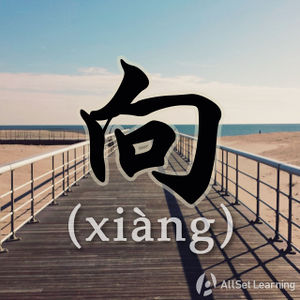Difference between revisions of "Comparing "chao" "xiang" and "wang""
| Line 6: | Line 6: | ||
都可以指明动作的方向或方位。当其组成的介词短语用在动词前面时,三个词的结构和意义是一样的,可以互换。 | 都可以指明动作的方向或方位。当其组成的介词短语用在动词前面时,三个词的结构和意义是一样的,可以互换。 | ||
| − | == | + | == When using "朝", "向", and "往" is appropriate== |
=== Structure === | === Structure === | ||
<div class="jiegou"> | <div class="jiegou"> | ||
| + | |||
| + | Just put one of the three before the direction and the verb! | ||
向/朝/往 + 具体方向 + Verb | 向/朝/往 + 具体方向 + Verb | ||
| Line 27: | Line 29: | ||
</div> | </div> | ||
| − | == | + | == When to use "向" and "往" == |
| + | |||
| + | 向 and 往 can be placed after the verb, however it has to be used with an appropriate verb, Often used verbs are 开, 飞, 发, 运, 送, 寄, 带, 驶 etc. As you can see, this are words that at least imply some sort of motion. In addition, compared to 向, 往 is used more often with those verbs, because 往 expresses the destination while 向 merely expresses a direction, 朝 cannot be used this way. | ||
"向"和"往"组成的介词词组可以置于动词之后,但不适用于所有的动词。常用的动词有“开,飞,发,运,送,寄,带,驶”等,而且相对来说,更常和“往”搭配,因为“往”表示的是最后要到的地方,“向”仅仅指明了一个方向。"朝"没有这种用法。 | "向"和"往"组成的介词词组可以置于动词之后,但不适用于所有的动词。常用的动词有“开,飞,发,运,送,寄,带,驶”等,而且相对来说,更常和“往”搭配,因为“往”表示的是最后要到的地方,“向”仅仅指明了一个方向。"朝"没有这种用法。 | ||
| Line 46: | Line 50: | ||
</div> | </div> | ||
| − | == | + | == When to use "向" and "朝" == |
| + | |||
| + | When the action that takes place is specified to a specific target, use 向 or 朝. 往 cannot be used this way. Also, when the verb is a concrete action, the use of 向 and 朝 are the same, and they can be interchanged. | ||
当后面跟动作的对象或目标时,"向"和"朝"可以,但是“往”没有这种用法。 | 当后面跟动作的对象或目标时,"向"和"朝"可以,但是“往”没有这种用法。 | ||
| Line 66: | Line 72: | ||
</div> | </div> | ||
| − | == | + | == When to use just "向" == |
| + | |||
| + | When the verb has an abstract meaning, you can only use 向, and you cannot use 朝. | ||
但是当其后的动词具有抽象意义的时候,只能用"向"不能用"朝"。 | 但是当其后的动词具有抽象意义的时候,只能用"向"不能用"朝"。 | ||
| Line 82: | Line 90: | ||
</div> | </div> | ||
| − | == | + | == Examples of right and wrong sentences == |
<div class="liju"> | <div class="liju"> | ||
| Line 98: | Line 106: | ||
</div> | </div> | ||
| − | == Dialog == | + | == Example Dialog == |
<div class="liju"> | <div class="liju"> | ||
Revision as of 07:47, 27 February 2013
-
Level
-
Similar to
-
Used for
-
Keywords
| This article is a stub. Editors can help the Chinese Grammar Wiki by expanding it. |
All three of these, 朝, 向, and 往 can be used to indicate direction or position. When these preposition phrases are used in before the verb, the three have the same structure and their meaning is the same. You can swap them in and out.
都可以指明动作的方向或方位。当其组成的介词短语用在动词前面时,三个词的结构和意义是一样的,可以互换。
Contents
When using "朝", "向", and "往" is appropriate
Structure
Just put one of the three before the direction and the verb!
向/朝/往 + 具体方向 + Verb
Examples
- 从 这里 向 / 朝 / 往 北 走 两 百 米 就 到 了。
- 这 个 小 女孩 向 左 看 看 又 向 右 看 看 才 过 马路。
- 我 看见 他 朝 你们 家 去 了。
- 往 前 走 十 分 钟。
When to use "向" and "往"
向 and 往 can be placed after the verb, however it has to be used with an appropriate verb, Often used verbs are 开, 飞, 发, 运, 送, 寄, 带, 驶 etc. As you can see, this are words that at least imply some sort of motion. In addition, compared to 向, 往 is used more often with those verbs, because 往 expresses the destination while 向 merely expresses a direction, 朝 cannot be used this way.
"向"和"往"组成的介词词组可以置于动词之后,但不适用于所有的动词。常用的动词有“开,飞,发,运,送,寄,带,驶”等,而且相对来说,更常和“往”搭配,因为“往”表示的是最后要到的地方,“向”仅仅指明了一个方向。"朝"没有这种用法。
Structure
Verb + 向/往 + 具体方向
Examples
- 这 趟 火车 开 往 沈阳。
- 这 趟 航班 飞 往 纽约。
- 一 辆 黑 色 的 小 轿车 慢慢地 从 东 驶 向 西。
- 像 鸟儿 一样 飞 向 蓝天。
When to use "向" and "朝"
When the action that takes place is specified to a specific target, use 向 or 朝. 往 cannot be used this way. Also, when the verb is a concrete action, the use of 向 and 朝 are the same, and they can be interchanged.
当后面跟动作的对象或目标时,"向"和"朝"可以,但是“往”没有这种用法。
而且当其后的动词是表示具体意义的动词时,"向"和"朝"的用法相同,可以互换。
Structure
向/朝 + 动作的对象 + 具体意义的动词
Examples
- 他 向 / 朝 我 笑 了 笑。
- 我 朝 他 开 了 一 枪。
- 他 已经 向 全体 员工 解释 过 了。
When to use just "向"
When the verb has an abstract meaning, you can only use 向, and you cannot use 朝.
但是当其后的动词具有抽象意义的时候,只能用"向"不能用"朝"。
Structure
向 + 动作的对象 + 抽象意义的动词
Examples
- 他 是 优秀 员工,我们 都 要 向 他 学习。
- 我们 要 向 环保 部门 要求 严查 工厂 排污。
Examples of right and wrong sentences
- 你 现在 是 开 往 市 中心 吗?
- 你 现在 是 开 向 市 中心 吗?
- 向 雷锋 同志 学习!
- 帅哥 向 我 笑 了。
- 帅哥 朝 我 笑 了。
- 你 现在 是 开 朝 市 中心 吗?
- 朝 雷锋 同志 学习!
- 往 雷锋 同志 学习!
- 帅哥 往 我 笑 了。
Example Dialog
- A: 他 往 南 走 了。
- B: 你 怎么 让 他 往 南 走 呢?南 边 很 危险。
- A: 你 朝 我 发 什么 火?我 说 了 他 不 听。
- B: 我 不 应该 朝 你 发火?难道 我 要 向 你 表示 感谢?
See also
Sources and further reading
Books
- 现代汉语八百词(增订本) ("向","朝"与"往"p.196) →buy
- 现代汉语虚词例释 (朝p.79, 向 p.505)




